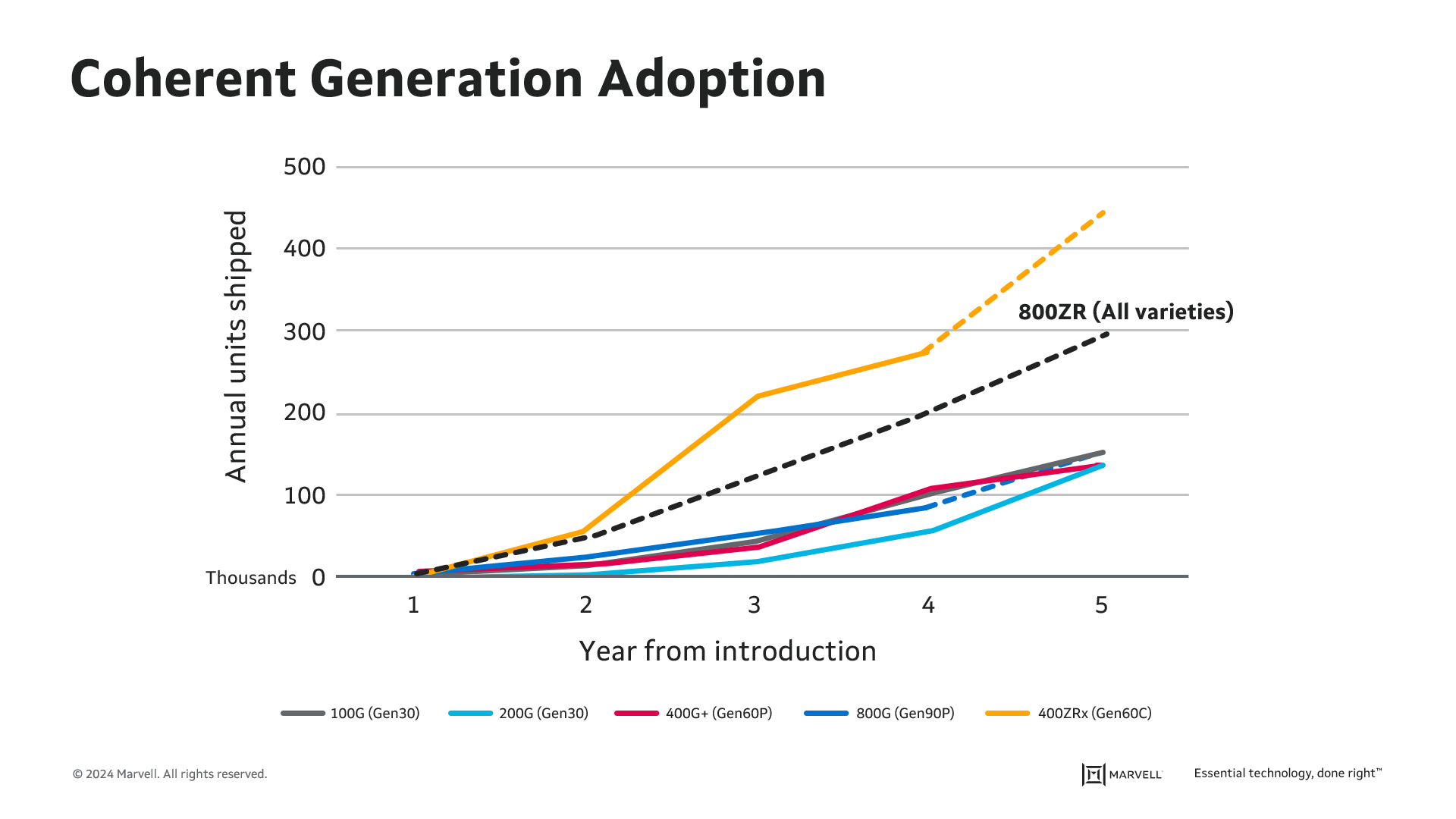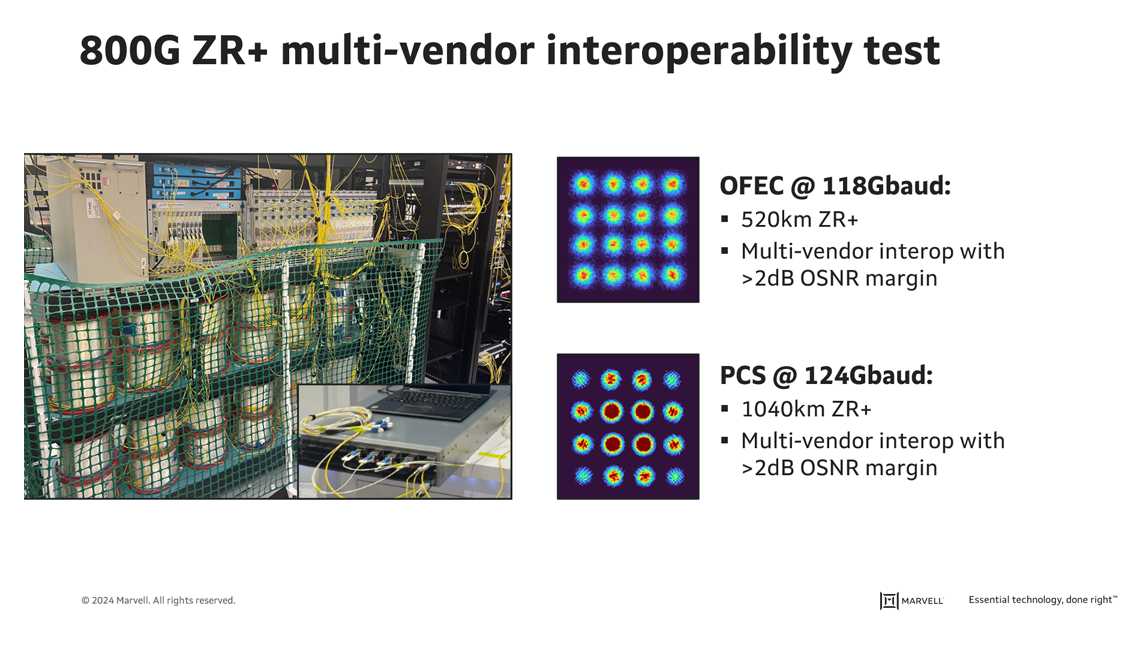Five Things to Know About the Future of Long Distance Optics
Coherent optical digital signal processors (DSPs) are the long-haul truckers of the communications world. The chips are essential ingredients in the 600+ subsea Internet cables that crisscross the oceans (see map here) and the extended geographic links weaving together telecommunications networks and clouds.
One of the most critical trends for long-distancer communications has been the shift from large, rack-scale transport equipment boxes running on embedded DSPs often from the same vendor to pluggable modules based on standardized form factors running DSPs from silicon suppliers tuned to the power limits of modules.
With the advent of 800G ZR/ZR+ modules, the market arrives at another turning point. Here’s what you need to know.
It’s the Magic of Modularity
PCs, smartphones, solar panels and other technologies that experienced rapid adoption had one thing in common: general agreement on the key ingredients. By building products around select components, accepted standards and modular form factors, an ecosystem of suppliers sprouted. And for customers that meant fewer shortages, lower prices and accelerated innovation.
The same holds true of pluggable coherent modules. 100 Gbps coherent modules based on the ZR specification debuted in 2017. The modules could deliver data approximately 80 kilometers and consumed approximately 4.5 watts per 100G of data delivered. Microsoft became an early adopter and used the modules to build a mesh of metro data centers1.

Flash forward to 2020. Power per 100G dropped to 4W and distance exploded: 120k connections became possible with modules based on the ZR standard and 400k with the ZR+ standard. (An organization called OIF maintains the ZR standard. ZR+ is controlled by OpenROADM. Module makers often make both varieties. The main difference between the two is the amplifier: the DSPs, number of channels and form factors are the same.) ®
The market responded. 400ZR/ZR+ became adopted more rapidly than any other technology in optical history, according to Cignal AI principal analyst Scott Wilkinson.
“It opened the floodgates to what you could do with coherent technology if you put it in the right form factor,” he said during a recent webinar.
2. Smaller is Better
Many of the advantages spring from the smaller, more convenient form factor. Classic transponder equipment comes in the classic pizza box form factor. Modules by contrast are the size of a mozzarella stick: 64 can be plugged into the back of switch.
That means a lower bill of materials, lower levels of cost and energy embedded in the manufacturing and shipping processes, less rack space, less real estate, lower installation and replacement costs and less power.
In a metro networks, modules can reduce the capex and opex associated with connectivity by up to 75%.

Additionally, the emergence of a standards-based ecosystem populated by a range of vendors--Lumentum, Coherent, HGG, InnoLight, among others--lowers the risk of vendor lock-in and shortages. (Marvell makes both DSPs, drivers and other components for modules produced by this broader ecosystem as well as Marvell COLORZ-brand modules for data center interconnects.)
3. The Performance Gap Is Gone
The ramp of 800G is expected to be fast, but not expected to match the trajectory of 400G, according to Wilkinson. (See below.) 800G, however, brings something else to the table: the performance gap between traditional embedded systems and modules goes away.
It took approximately 4 years for 100G pluggables to catch up to the performance and reach of embedded DSP-based equipment, he noted. With 400G, it took three years. With 800G, it will be a year and possibly less because DSPs integrated into pluggable modules come from the more recent 120 baud generation.
A gap might exist, but it is “neutralized,” he said. “That’s never happened before.”

Source: Cignal AI Optical Components Report Q1 2024
Lumentum, Coherent and Marvell recently demonstrated that modules from all three vendors based around the Marvell Orion coherent optical DSP can interoperate at 520km.
800G can also be used in different modes to reach further distances. At 600 Gbps, a popular performance standard for carriers in China, a link will transmit for 1,200km (London-Vienna). At 400 Gbps, the same module can travel 2,000km1.
To date, ZR/ZR+ pluggable modules have operated for over 10 billion hours in the field1.

4. PCS Comes to Pluggables
Probabilistic Shaping Technology (PCS) effectively concentrates signal in the four interior channels (see below). A recent test with Lumentum and Marvell showed interoperability at over 1,000 km at 800 Gbps. At 400 Gbps, the same PCS-enabled modules are designed to be able to transmit for 2,500 kilometers or more1. (Tokyo to anywhere in Taiwan.)
PCS, in fact, enables pluggable systems to approach the Shannon limit. Named after Claude Shannon, the limit defines the maximum amount of data that can be theoretically transmitted over a channel without errors at a particular noise level.
Until now, PCS has largely been confined to embedded systems. Orion brings it to the pluggable world.

Put another way, with 800G optical DSPs and PCS, pluggable module makers can produce devices that will cover roughly 80-85% of the use cases1. Embedded systems will maintain an edge for continuous transcontinental or oceanic links, but pluggables will compete everywhere else.
5. 1.6T Is Under Way
While 800G coherent DSPs and modules began sampling last year and are now starting to become more commercially available, work is already underway for 1.6T modules and DSPs. OIF has already launched an effort to define the specifications and performance characteristics. The target specification for 1.6T ZR is 120km of reach under 2W per 100G of data. (Link lengths and power requirements for ZR+ modules have yet to be determined.) PCS is also slated to be part of 1.6T.
Due to the rapid rate of progress, Wilkinson has even speculated that 1.6T may actually provide greater performance than embedded systems when they debut.
1 Marvell
# # #
Marvell and the M logo are trademarks of Marvell or its affiliates. Please visit www.marvell.com for a complete list of Marvell trademarks.
This blog contains forward-looking statements within the meaning of the federal securities laws that involve risks and uncertainties. Forward-looking statements include, without limitation, any statement that may predict, forecast, indicate or imply future events, results or achievements. Actual events, results or achievements may differ materially from those contemplated in this blog. Forward-looking statements are only predictions and are subject to risks, uncertainties and assumptions that are difficult to predict, including those described in the “Risk Factors” section of our Annual Reports on Form 10-K, Quarterly Reports on Form 10-Q and other documents filed by us from time to time with the SEC. Forward-looking statements speak only as of the date they are made. Readers are cautioned not to put undue reliance on forward-looking statements, and no person assumes any obligation to update or revise any such forward-looking statements, whether as a result of new information, future events or otherwise.
Tags: Optical Connectivity, high speed optical connectivity, Optical Interconnect, data center interconnect, server connectivity, Data Center Interconnects, PAM4 DSP-based Optical Connectivity, Network connectivity, DSP based Optical Connectivity, Data Center Interconnect Solutions
Recent Posts
- Custom Silicon: A Sea Change for Semiconductors
- Marvell Named to America’s Most Responsible Companies 2026 List
- 5 Times More Queries per Second: What CXL Compute Accelerators Can Do for AI
- Marvell Makes Inaugural 100 Best Companies in Southeast Asia List
- Marvell Earns “Fittest Firm” Title in Silicon Valley Turkey Trot for 10th Consecutive Year

